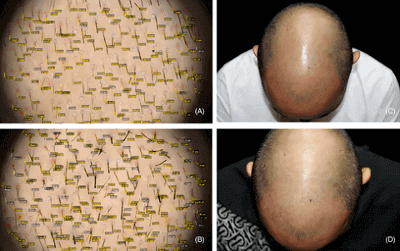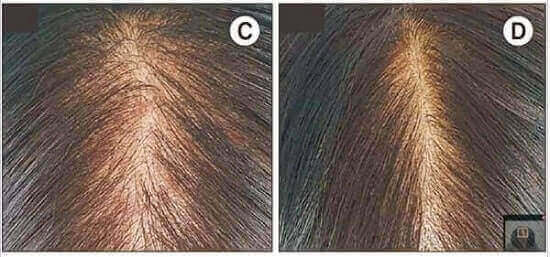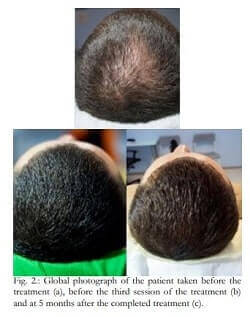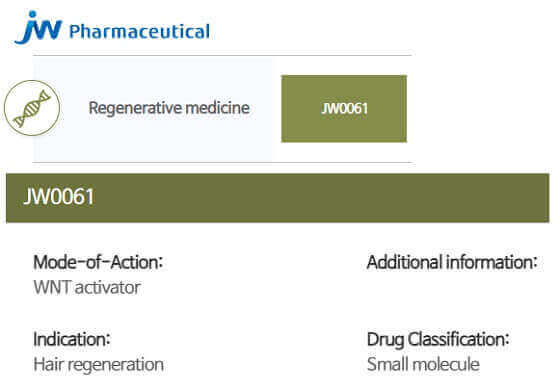Fractional Erbium:YAG (or Er:YAG) lasers can lead to scalp hair growth per a number of recent studies. Both ablative and non-ablative Erbium lasers have been used to treat hair loss.
Note that the fractional lasers discussed in this post have significantly higher wavelengths (1,500-3,000 nm) than typical low-level laser therapy (LLLT) home-use devices (650 nm). Fractional laser treatments must be undertaken at professional clinics and never at home.
Fractional laser treatments are unique in that they work at both the upper epidermal and lower dermal layers of the skin. Other laser light treatments are either ablative or non-ablative.
Here is some information on ablative versus non-ablative lasers and on fractional lasers. Also see this excellent overview from 2012 of all four combinations of lasers being implied here. Note that fractional carbon dioxide (CO2) lasers have also been used for hair growth.
The bottom part of this post is the original that was first written in 2015. The top part is all recent updates.
Update: June 11, 2024
Lumenis FoLix™: The First FDA-cleared Fractional Laser to Treat Hair Loss
Lumenis (Israel) has just introduced FoLix™, the first FDA-cleared proprietary fractional laser for the treatment of hair loss. Lumenis’ pre-clinical and clinical studies showed a positive impact on hair growth after using FoLix. Lumenis claims that its laser gives results within “four to six monthly sessions”.
FoLix is a non-ablative fractional laser device. Note that in the above link, it says the laser can only be used in adult males and females with Fitzpatrick skin types I to IV. More details about FoLix can be found here.
Update: January 21, 2024
Non-Ablative Fractional Laser Superior to 5% Minoxidil
A new study from China (h/t “Kyle”) just found that a 1565 nm non-ablative fractional laser (NAFL) exhibits superior hair growth in comparison to topical minoxidil 5%. The better results were seen in: total hair count; total hair density; terminal hair count; terminal hair density; number of follicle units; and average hair numbers per hair follicle unit. Quite convincing.
The study consisted of 30 male participants with androgenetic alopecia (AGA). Half got treated with the lasers, and the other half with minoxidil. No significant side effects were noticed. Below is one of the before (baseline) and after (week 10) photos. While the hair regrowth is not easily evident in the scalp photo, the magnified close-up and the tables in the actual study garner greater confidence.

Update: April 14, 2022
Er:YAG Lasers for Hair Growth
A number of new studies have been published since I originally wrote this post. All seem to use the Erbium lasers for hair growth.
— Ablative fractional 2940-nm erbium:YAG laser to treat hair loss in a male Korean patient. They used the locally made PURAXEL laser. The before and after photo from this September 2021 study is shown below:

— A study from August 2021 concluded that a non-ablative 2940-nm Er:YAG laser is an effective tool in the treatment of androgenetic alopecia. The authors made use of the Fotona’s SP Dynamis laser system in SMOOTH ™ mode.

— A unique 2021 study from Russia found that combination therapy consisting of non-ablative 2940-nm Er:YAG laser plus platelet-rich plasma injections resulted in very significant hair regrowth.
The SP Dynamis (Fontona) fractional laser was utilized in SMOOTH™ mode. The before and after image on the right is impressive.
May 11, 2015
Fractional Laser Hair Growth via Wounding
The reason I thought about lasers again this week is because several days ago an interesting May 2015 article from South Korea was published in the Lasers in Surgery and Medicine journal.
The conclusion of this article is that ablative fractional lasers appear to be effective in inducing hair regrowth via activation of the Wnt/Beta-Catenin pathway. I have discussed the Wnt/Beta-Catenin pathway in numerous posts on this blog before. Note that the way these lasers work is somewhat related to the concept of wounding and hair growth.
Apparently, even before this latest development, there have already been a few published journal articles from Asian researchers covering both ablative and non-ablative fractional lasers and their positive impact on hair growth. For example see:
- April 2015: Enhancing hair follicle regeneration by non-ablative fractional erbium-glass laser: The laser wavelength was 1550 nm. Note that the erbium laser is almost always ablative, but this one was non-ablative.
- December 2011: The effect of a 1550 nm fractional erbium-glass laser in female pattern hair loss.
- January 2011: Fractional photothermolysis laser treatment of male pattern hair loss. Also using the 1550 nm erbium-glass laser.
In the latest South Korean study in mice, it was found that the most effective (ablative) laser dosage was “the 10 mJ/spot and 300 spots/cm2 setting”. Hopefully some of these scientists will soon conduct studies on humans.
It does seem like light amplification by stimulated emission of radiation (LASER) can now legitimately be considered as a tool in the fight against hair loss. It is likely that in the years ahead, scientists will experiment with many newer lasers and with various duration and power settings.
